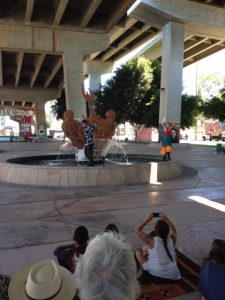Trolley Dances soars with choir and murals; sparks talk about homeless
It’s just a few exits south of downtown under the majestic San Diego/Coronado Bay Bridge, but for many in San Diego, Chicano Park in the community of Barrio Logan may seem like a world away. That makes it the perfect spot for this year’s Trolley Dances, which begins at the Barrio Logan Trolley Station and runs for two weekends, Sept. 28 and 29, Oct. 5 and 6.
The cultural adventure has been bringing dance to neighborhoods and unlikely places for 15 years. Creator Jean Isaacs, and her San Diego Dance Theater, partners with the Metropolitan Transit System. Together they slog through a logistical swamp of permits, insurance, and red tape, and finally select unique areas to discover and set dances, such as empty lots along the trolley tracks, fountains, stores, apartments, and several libraries.
This year’s tour features six site-specific dances, five choreographers, and 45 performers. It opens with a dance by Isaacs on a patio with an interactive water feature outside the Northgate Gonzalez Market.
Eight dancers play in and around spurts of water shooting out of the concrete. Dressed in white with pops of neon color on their legs, they become human rainbows, prisms under bright sunlight beating down. Dancer Cecily Holcombe rests on her back in the cool water spray. Others grab an ankle and stretch into proud extensions. There is a sense of reverence and connection to the sky and sun, earth and water.
A wonderful transition has those dancers beckon us forward to the next site. Catching a glimpse of them waving then disappearing around the corner is a brief yet inviting experience. It also prepares us for Kim Epifano’s dance amidst giant murals painted on pillars and ghosts from the past.
“Welcome to Chicano Park, April 22, 1970, center of the world!” Epifano calls out, as Julio Velasquez circles at high speed on a bicycle through the pillars.
The murals are stunning and warrant a full day’s viewing. They symbolize the struggle for the liberation of Chicano Mexicanos and the protest to secure city land for a public park. The community lost its beach access to the Navy in World War II, and it was ripped in half by Interstate 5. And it still struggles with zoning laws that mix residences and polluting industrial sites.
Epifano’s dance has a respectful, yet surreal tone. She creates a circus atmosphere, appearing as a ring leader in turquoise under the big top, which is the bay bridge, a giant concrete tent. She directs Velasquez on his bike and conjures a partner for him.
Dressed in a bright skirt and sturdy high boots, Sadie Weinberg appears in the distance – you wonder if she’s part of the show or just passing by – and soon she and her man dance and rebound on the edge of a fountain. A dreamy sound mix conspires with the spiraling bike and bodies to make you dizzy – Are we all time travelers sent to another era? And more so, there’s a feeling of ghosts and giant eyes in the pillars looking down.
All senses are in overdrive during Isaacs’ second dance, accompanied by the Sacra Profana Vocal Ensemble hidden in the rafters of the Monarch School lobby. The choir is a sonic injection of joy with harmonics that make your skin tingle.
Eight dancers burst and scatter with the precision of rotating planets in an orbit. Arms roll up and down so fast they blur. The group charges forward, but recoils as if hitting an invisible wall. They keep a relentless pace. Even in the small space, they stay in unison, and carry each other, pausing only to glance upward toward the heavenly sound.
The Monarch school serves students impacted by homelessness; the emotional strains of the dance certainly tap into that struggle. The choir does not perform for every tour, so keep that in mind when planning your trip. And don’t be afraid to move around to find a different view.
The tour snakes outside the Monarch campus for two more dances. Choreographer Kate Watson-Wallace, from Philadelphia, switches gears with a pulsing beat and dancers grooving on a grassy circle ringed by an asphalt tricycle path.
Dancers introduce a frenetic language of hands flapping. They run into the center and slide over dried out grass. They carefully brush off grass like preening apes. Sirens whine in the distance, then there is silence, and all bodies form an arc on the edge. Mechanical arms press at the elbow. Shoulders shake.
Watson-Wallace loves improvisation and is known for staging dance viewed from inside cars, but here everything seems set, choreographed, and planned. Then on opening day, a little girl from the crowd tried to join the dancing, which is just one of many wild cards possible in site-specific dance.
A short walk later, we hear violin strings (recording by Olafur Arnalds) and see Justin Viernes on the top of a three-tiered amphitheater. More dancers dressed in shades of orange and black gather. Excitement builds. The work by Khamla Somphanh features some of the strongest and most respected performers in town – such as Viernes, Nikki Dunnan and Stephanie Harvey – and they all dance on bone-crushing concrete with confidence as if hopping over globs of icing on a cake. The work reaches its pinnacle when the men swing on a wrought iron fence. A towering Hilton Hotel and red trolleys in the background provide layered perspectives.
This Trolley adventure demands more walking and less trolley riding than in years past. Before hopping aboard the trolley for the single ride to the multi-million-dollar Central Library, there is a humanitarian stopover.
Trolley Dances takes a shortcut – through the heart of a homeless shelter filled with men and women atop blanketed bunks, all run by Alpha Project. Then it’s onto the trolley to reflect and regroup.
On opening day, several people whispered about the homeless camp. A few griped about the awkward experience, though the resounding refrain seemed to be one of determination, taking a vow to be more engaged with the plight of the homeless community.
Opening day for Trolley also coincided with the opening of the Central Library. Throngs of people – many pushing strollers and gripping the hands of toddlers and grandparents – coiled around the area. A rock-n-roll band blasted over-amped something.
It’s difficult to discern where and when the dance begins on the steps of the library. Created by Kyle Sorensen, the final piece has no reference to books, but becomes a chameleon experiment, a dance designed to blend in with the new library commotion.
Sorensen has danced in several Trolley Dance events and has been dancing with SDDT for more than a year. He is set to leave for Israel to study dance and choreographic processes on Fullbright Fellowship.
For this final dance, his process has men and women in pedestrian clothes move up and down a stairway in an endless loop, as if on an invisible escalator. The garbled score is “Lomond” by Loess, mixed with “My Body is a Fiesta,” by Ataraxic. (Some may recognize “Fiesta” from the popular image of a nude woman with writing on her skin). The score blathers on – “it was an epoch,” “I was born twice,” – and men and women meet somewhere in the center of the stairway. A tiny woman carries a man.
The endless cycle of bodies scrambling and teetering on a ledge is striking to watch. Ironically, their beauty and precision goes unnoticed, and sadly, like too many homeless people, they blend into the crowd.
Krishan Oberoi and SACRA/PROFANA http://sacraprofana.org/
San Francisco Trolley Dances Oct. 19, 20. www.Epiphany.org
Riverside Trolley Dances Oct. 19, 2013 www.Trolleydancesriverside.com

Kris Eitland covers dance and theater for Sandiegostory.com and freelances for other publications, including the Union Tribune and Dance Teacher Magazine. She grew up performing many dance styles and continued intensive modern dance and choreography at the Univ. of Minnesota, Duluth, and San Diego State Univ. She also holds a journalism degree from SDSU. Her career includes stints in commercial and public radio news production.
Eitland has won numerous Excellence in Journalism awards for criticism and reporting from the San Diego Press Club. She has served on the Press Club board since 2011 and is a past president. She is a co-founder of Sandiegostory.com. She has a passion for the arts, throwing parties with dancing and singing, and cruising the Pacific in her family’s vintage trawler. She trains dogs, skis, and loves seasonal trips to her home state of Minnesota.

